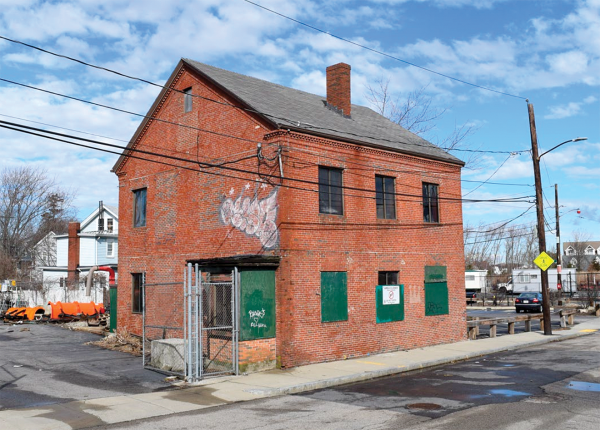April 19, 2023

The house in question.
DCR image
Port Norfolk residents rallied to block state environmental officials from taking down a vacant brick building that overlooks the Neponset River, arguing that it has historical value as the former counting house of the long-gone Albert T. Stearns Lumber Company.
Neighbors who abut the two-story building, located at 98 Taylor St., received a notice saying the state Department of Conservation and Recreation (DCR), which now owns the property, is seeking to tear down the Greek Revival-style building.

A birds-eye view of 98 Taylor Street and its surroundings. DCR image
The Massachusetts Historical Commission determined last year that the demolition is unlikely to have a historic or archeological impact, but locals say they disagree.
“We understand that the renovation of the building would be quite expensive, but we do not believe that all alternative methods of funding for renovation and preserving the building have been explored,” John Lyons, president of the Port Norfolk Civic Association, wrote in an April 14 letter to state officials.
After state Rep. Dan Hunt and District 3 Councillor Frank Baker added their support for a pause, a DCR spokesperson on Tuesday said the proposal is now on hold as the agency seeks more community input and a new commissioner, outgoing Revere Mayor Brian Arrigo, arrives.
In his letter, Port Norfolk’s Lyons noted that it is the last standing building of a company that received lumber via schooners and that DCR has a historical panel located across the street at Joseph Finnegan Park laying out its history.
The company’s lumber built much of Dorchester and South Boston, he added, and the building, which was erected before the Civil War, represents the industrial and maritime history of the Port Norfolk neighborhood, which once served as the city’s secondary port.
Michael Manning, chair of the Friends of the Boston Harborwalk and an engineer, sent his own letter to Arrigo, expressing his dismay over any demolition.
The Stearns yard once spanned 40 acres and 14 buildings. “Over a hundred-plus years, Port Norfolk hosted manufacturing firms that produced nails for both horseshoes and building construction (Putnam Nail Company), sailing boats and warships (George P. Lawley and Son), and lumber products (A.T. Stearns Lumber Company),” he wrote, noting that “there were many other firms but these three are the most notable.”
Earl Taylor, president of the Dorchester Historical Society, said his group considers the building to be an “important part” of Dorchester’s heritage, “both in its architectural style and as a reminder of our commercial and social history. We strongly urge that the building not be demolished but be saved and adapted to a new use.”
Department of Conservation and Recreation officials on March 23 submitted a notice of intent to demolish the building to the Boston Conservation Commission. The takedown notice was on the agenda for the Conservation Commission meeting this week, but was withdrawn ahead of the meeting.
The site, which also goes by the address 113-115 Walnut Street, is used by DCR maintenance staff as a yard for vehicle and equipment storage.
DCR tapped infrastructure consulting firm AECOM to write the notice of intent, which said the building is “deteriorating” and laid out plans to backfill the area, after the building is demolished, with crushed stone to match the rest of the storage yard.
The notice referenced studies that found “extensive” issues with the brick exterior, bowing of walls, and water damage inside. Repairing and rehabilitation would cost over $1 million, according to AECOM.
“Mold growth inside the building has reached hazardous levels, and the condition of interior finishes has worsened,” said the notice, filed with the Conservation Commission.
“In recent months, despite its location in a fenced yard with secured window and door openings, the building has become an attractive target for break-ins by homeless populations.”


